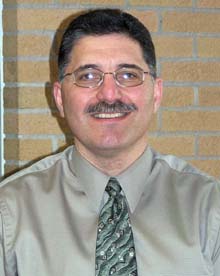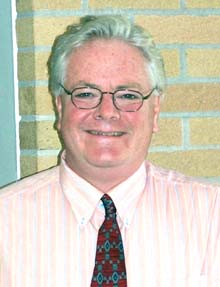
Their enthusiasm to handle the challenges ahead is tangible in the conference room as they outline plans for the future. The recently appointed Interim CEO of Lakeside Health System, Michael Perry, and Interim President, Kevin Nacy, are prepared to manage the coming months, and possibly longer, as senior administrators. There is nothing temporary in their vision for improving and strengthening the hospital’s health facilities. They have set about the work they and the Lakeside Board of Directors believe needs to be done. Transitions The board and administrators heard at a public forum earlier in May that the community valued the OB unit and did not want it closed. Ultimately the leadership concluded that “the most effective and efficient provision of these services is to maintain OB care at Lakeside Memorial Hospital,” according to a press release (5.12.05) There were 301 births at the hospital in 2004, down from 600 in years previous. How will a department declining in vitality be brought back to life? Perry says key to revitalizing the unit will be recruiting and drawing in new physicians, continuing the liaison the health care facility has with nearby Oak Orchard Community Health Center and continuing to offer the services of a midwife or midwives for deliveries. Additionally, the administration is defining a plan to update the facilities and amenities to make them attractive to parents-to-be as they consider where to have their child, and to bring this department up to par with what other hospitals offer. Using capital campaign funds generated from the community and grants, including a $300,000 Kresge grant which was a cornerstone of the Building for the Next Generation Campaign in 2001, a scaled down version of the OB unit’s facelift which was once planned will still address modernization needs to bring equipment and facilities up-to-date. In order to pursue the OB unit’s rehab, the board and administrators agreed to trim a planned $8 million surgical wing. Instead, refurbishing of the operating suites and the OB rooms will happen in tandem as part of an approximately $2 million project. “We expect to have the shovel in the ground in June 2006,” Nacy said, with changes and improvements happening on the west side of the building in an area where a courtyard currently exists. He and Perry will work through the approvals needed from the state for Certificate of Need (CON) permits for the project and say they will keep local government apprised of changes in their earlier plans to expand parking and enlarge the building footprint as previously planned. In the OB/GYN area, three labor-delivery-recovery-postpartum rooms will be created. Commonly called LDRP suites, the area will offer mothers the use of the same room for their entire delivery, rather than moving between two or more rooms as is the current practice. Those who need Cesarean sections would be offered use of a room with its own shower facility, providing more privacy than available now. Perry said the improvements to OB and surgical areas have the complete approval of the Board of Directors. The end result will be comprehensive, offering “thoroughly modern facilities that will allow us to bring more quality care to the community.” “We are not cutting back -- we will grow in stages,” the Interim CEO said. “We will meet the current needs of the community and have extra for future needs as they are made known.” Changes to Lakeside will be visually apparent before the anticipated 2006 groundbreaking for the surgical and OB updates. At the end of July, the front of the complex, which is often referred to as the old hospital, will be refaced and new windows and doors installed. The look will match the existing newer construction and will definitely “refresh” the street-side appearance of the Brockport landmark. Economics Areas which are growing include the orthopaedic unit, the field which involves the correction or prevention of skeletal deformities. To augment the unit, Perry and Nacy said they are working to recruit a doctor who would come to the hospital to perform joint replacment surgery. If needed, patients could opt to stay in the hospital’s rehab center which accesses the physical therapy department. With the availability of new specialists such as those in orthopaedic care, patients reap the benefits of highly qualified staff combined with personalized care sometimes sacrificed in the much larger health centers. The affiliation of these specialists in the ‘close to home’ setting of the Brockport hospital provide patients with the same professionals affiliated with the University of Rochester’s Strong Memorial Hospital, for example, without them needing to travel longer distances out of the area. In turn, patients of the new specialists use hospital departments including radiology and physical therapy and other services. Increased use in all these areas has contributed to the hospital administration’s expectations for ending 2005 with a surplus. Lakeside’s strengths “This is a small hospital, but we won’t settle for second best in treatment or care,” Nacy said. Lakeside is participating in a nationwide initiative called 100,000 Lives inspired by Dr. Don Berwick, CEO of the Cambridge, Massachusetts-based Institute of Healthcare Improvements (IHI). Berwick wants to save 100,000 lives by 9 a.m. June 14, 2006 by improving the system of providing health care through six initiatives addressing such areas as reducing ventilator-associated pneumonia, drug errors and surgical site infections. (For more information on the goals visit the Institute for Healthcare Development at www.IHI.org). Adminstrators said they are on board with other hospitals regarding these goals to improve. “This is an exciting transitional period for us,” Perry said. At Lakeside since 1999 and with 30 years of experience in health care areas, he is also Lakeside’s senior vice president for Long Term Care. “Healthcare is not stagnant,” Perry said. “We need to keep our options open for providing services now and in the future -- one, three, five, 10 years down the road. Healthcare is fluid and we need to adapt services to meet community needs. … Who we are and what we do will center around providing quality health care to the community.” “Although we already have many specialists, we need to aggressively recruit additional specialists to perform services at Lakeside,” Nacy said, “for out patient and in patient services, and to have the availability of quality emergency and longer-term treatment to care for the needs of the community. We can provide 90 percent of the care needs right here at Lakeside.” … “We don’t have to have community people going out of the area for treatment.” Note: In June, Westside News Inc. will review the new services offered at Lakeside Memorial Hospital for spine problems and injuries and other orthopaedic care options. |
||||

